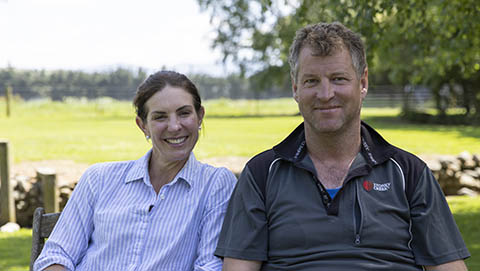Cust dairy grazers Gary and Penny Robinson are anticipating a season of “data collection” after installing a subsurface drip irrigation system on an 18-hectare block of land which is part of a 260-hectare farm in Maniototo, Central Otago. They aim to collect data from both this block and their trial site in Cust to analyse the benefits of subsurface drip irrigation (SDI).
Gary and Penny are participating in a project which examines how the next generation of farmers are using innovation to improve their farming practices. Waimakariri Landcare Trust (WLT) and Waimakariri Irrigation Limited (WIL) have partnered with the Ministry for Primary Industries (MPI) for the project, with support from MPI’s Sustainable Food and Fibre Futures fund along with Environment Canterbury, Ballance, and DairyNZ.
After a wet summer last year scuppered plans to collect data from their trial block, the couple were delighted when their partner Carrfields approached them for an installation opportunity in Maniototo. Gary says the site is an ideal location for installing subsurface drip irrigation.
“Part of it is a corner of a pivot on existing grass and the rest is worked up land. It contains two different soil types so it will be interesting to compare how the SDI performs on those soil types and then we can also compare that to our trial block in Cust. It goes dry down there in Central Otago, so we are hoping to fetch some good data.”
During the installation process several neighbouring farmers visited the Maniototo site to learn more about subsurface drip irrigation. They expressed interest in trialling the system if the data gathered from the system proves the benefits.
With less water potentially available for irrigation in the future and stricter regulations regarding nitrogen run off into streams and rivers being introduced, Penny says the economic and environmental benefits of subsurface drip irrigation are clear.“SDI provides water directly to the root zone, so you use less water more efficiently when compared to a traditional irrigation system. There is zero leaching of nitrates as you don’t apply a lot of water because you are not saturating the soil from the top down but slowly and steadily from the roots of the plant.”
Measuring the quality of the yield of the crop or pasture produced using subsurface drip irrigation is also an important aspect of data gathering. Penny describes how they will work with project partners Carrfields and Ballance at their trial block to measure pasture yield and quality.
“We will mow patches of pasture on our trial block where the SDI is installed and weigh it to get an indication of how many kilos of dry matter per kilo we have per hectare and then compare this to the same pasture in an area where SDI is not installed.
“Obviously, we want increased yield but not increased yield of poor pasture. We are looking for increased yield of high ME (metabolisable energy) pasture.”
Gary and Penny were finalists in the recent Irrigation New Zealand Innovation in Irrigation Award. While they didn’t win the award, being able to network with people and organisations with a keen interest in new types of technology was important for creating connections.
Farm environmental consultant Rebecca Hyde nominated Gary and Penny for the award as she could see the benefits of providing farmers with efficient irrigation from her work with North Canterbury farmers.
“I know Gary and Penny personally, so I have seen their journey with subsurface drip irrigation progress right from the beginning. I have seen the need for farmers to use less water more efficiently as some landowners are now seeing a decrease in the amount of water they can use on farm.
“In the corners of pivots, traditional sprinklers and K-line irrigation will struggle whereas SDI is perfect for these areas.
“I can also see the benefits of using SDI in urban settings like parks and golf clubs where we now have to be more aware of the amount of water we are using and try to get it in the right place at the right time.”
Penny and Gary will host a field day at their trial block in February for local farmers and industry partners to learn more about subsurface drip irrigation.
“It will be a good opportunity to see the system in action and we should have some data to present by then. We are looking forward to being able to showcase what we believe will be the future of irrigation in New Zealand.”

Cust dairy grazers Gary and Penny Robinson will collect data from their North Canterbury trial block and from a new subsurface irrigation system they installed in Central Otago to prove the benefits of underground irrigation.